10 Stunning Plants That Attract Butterflies to Your Garden
Ready to transform your outdoor space into a butterfly haven? These 10 spectacular plants not only add beauty to your industry but also serve as butterfly magnets, providing essential nectar and host plant options for these delicate pollinators.
- Butterfly Bush (Buddleia) – This aptly named shrub produces long, fragrant flower clusters in purple, pink, or white that butterflies simply can’t resist. Growing up to 10 feet tall, butterfly bush blooms from summer through fall, creating a constant nectar source.
- Milkweed (Asclepias) – Essential for monarch butterflies, milkweed serves as both a nectar source and the only host plant where monarchs lay their eggs. Plant native varieties like common milkweed (Asclepias syriaca) or butterfly weed (Asclepias tuberosa) for best results.
- Purple Coneflower (Echinacea purpurea) – These drought-tolerant perennials feature distinctive purple-pink flowers with raised centers that attract many butterfly species. Their long blooming period provides nectar from midsummer through early fall.
- Lantana (Lantana camara) – Offering clusters of tiny, multicolored flowers in orange, yellow, pink, and red, lantana thrives in hot conditions and blooms continuously from spring until frost, making it a butterfly favorite in warmer regions.
- Aster (Symphyotrichum) – These late-season bloomers provide crucial fall nectar when many other flowers have faded. Available in purples, pinks, and whites, asters support many butterfly species preparing for migration or winter.
- Black-Eyed Susan (Rudbeckia) – These cheerful yellow flowers with dark centers bloom prolifically from midsummer through fall. Easy to grow in most conditions, they attract painted ladies, fritillaries, and many other butterfly species.
- Joe-Pye Weed (Eutrochium) – Reaching heights of 5-7 feet, this native perennial produces large, mauve flower clusters in late summer that attract swallowtails, monarchs, and skippers with their abundant nectar.
- Zinnia (Zinnia elegans) – These annual flowers bloom in nearly every color of the rainbow and provide landing-pad-style blooms perfect for butterflies. Plant in full sun for continuous blooms from summer until frost.
- Blazing Star (Liatris) – With tall purple spikes that bloom from top to bottom, blazing stars provide weeks of nectar for butterflies. Their unusual vertical growth habit adds structural interest to butterfly gardens.
- Fennel (Foeniculum vulgare) – This herb serves as a host plant for swallowtail butterflies while its yellow flower umbels provide nectar for adult butterflies. The feathery foliage adds texture to garden beds and containers.
Why Butterflies Are Important for Your Garden Ecosystem
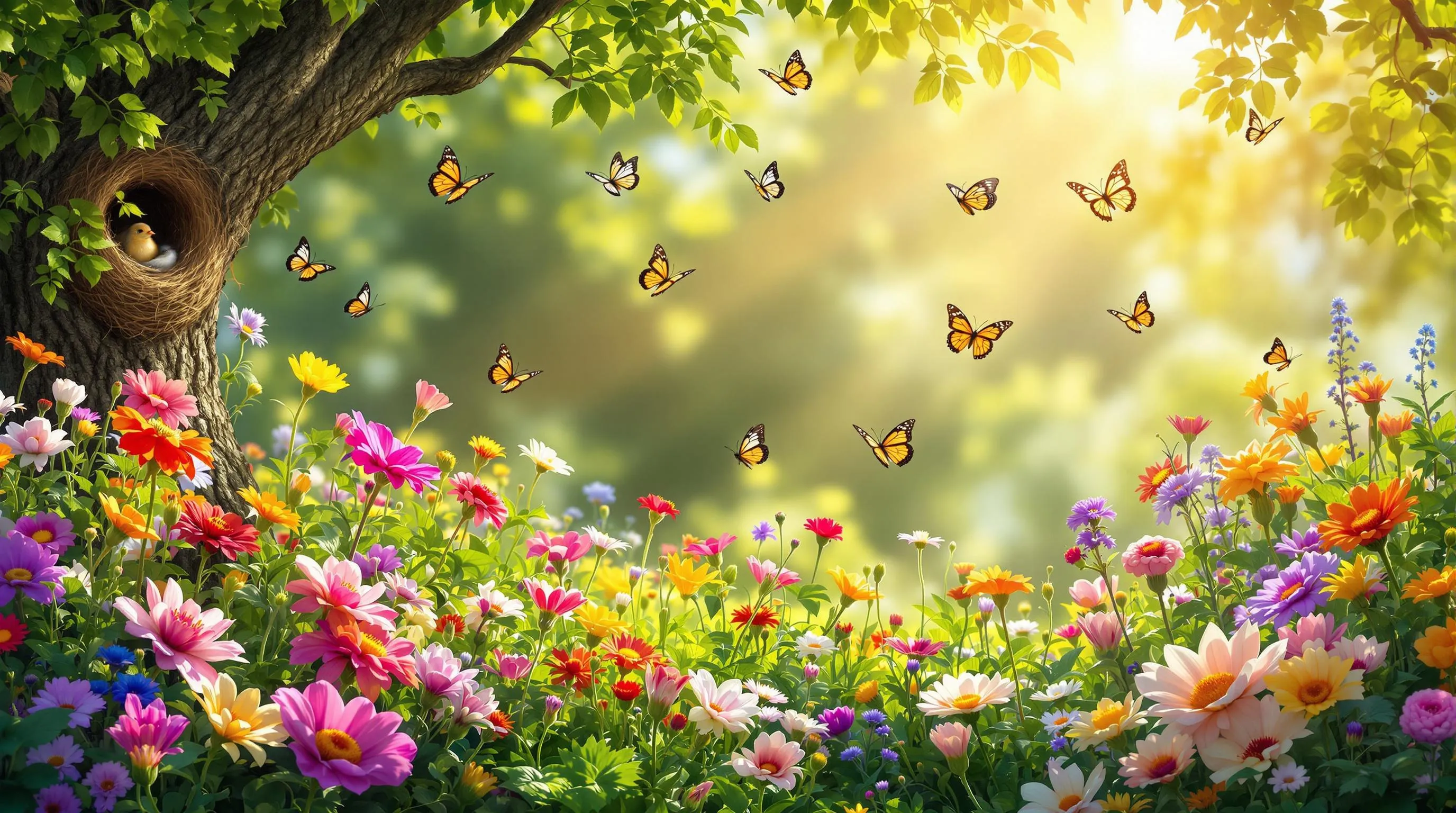
Butterflies are more than just beautiful visitors to your garden—they’re essential components of a healthy network. These delicate creatures play vital roles that benefit your plants, other wildlife, and the broader environment.
The Role of Butterflies as Pollinators
Butterflies serve as critical pollinators for many flowering plants in your garden. As they feed on nectar, pollen sticks to their bodies and legs, which they then transfer to other flowers during their feeding rounds. Unlike bees that target exact plants, butterflies pollinate a wider variety of flora, including many wildflowers that other pollinators might miss. This cross-pollination helps maintain genetic diversity in plant populations, resulting in stronger, more resilient plants. Gardens with abundant butterfly activity typically show increased flower production and fruit yields, directly benefiting your harvests of vegetables, fruits, and berries.
How Butterflies Contribute to Biodiversity
Butterflies are excellent indicators of environmental health—their presence signals a thriving network. They occupy a crucial position in the food chain, serving as prey for birds, bats, and other predators while their caterpillars provide essential nutrition for growing bird families. Different butterfly species require exact host plants for their larvae, creating specialized ecological relationships that enhance biodiversity. By attracting butterflies to your garden, you’re supporting dozens of other species within this interconnected web. Also, butterflies undergo complete metamorphosis (egg, larva, pupa, adult), offering opportunities to observe and learn about natural life cycles right in your backyard.
Butterfly-Friendly Nectar Plants for Sunny Gardens
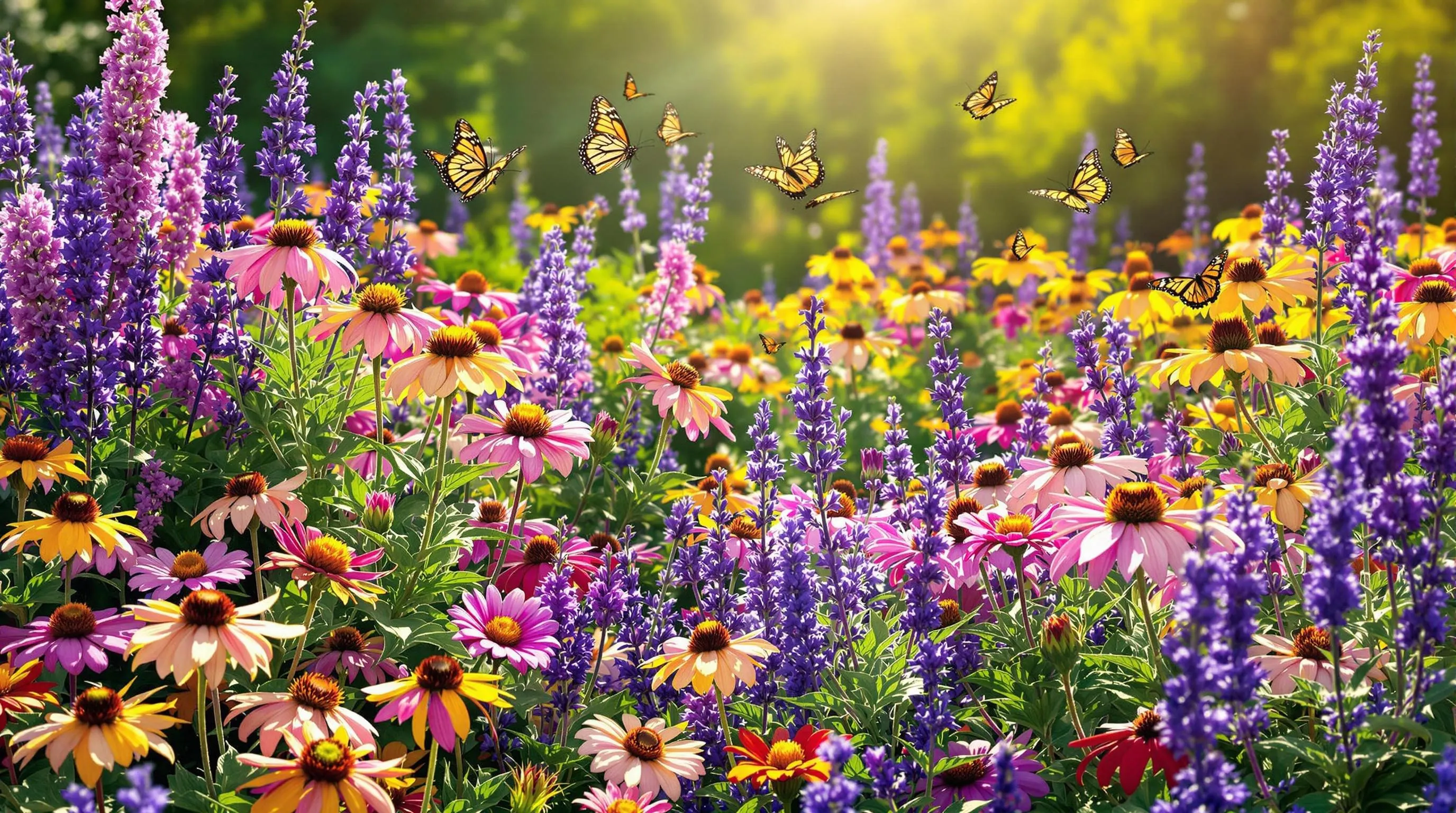
Sunny garden spots provide the perfect environment for growing nectar-rich plants that butterflies adore. These sun-loving bloomers not only create vibrant splashes of color in your industry but also serve as essential fuel stations for adult butterflies.
Colorful Coneflowers (Echinacea)
Coneflowers rank among the most reliable butterfly magnets for sunny gardens, blooming from midsummer through fall. Their daisy-like flowers with raised central cones provide landing platforms where butterflies can perch while feeding. Plant purple coneflower (Echinacea purpurea) for its drought tolerance and long-lasting blooms that attract monarchs, painted ladies, and swallowtails. Newer cultivars offer a rainbow of colors from white to yellow, orange, and deep magenta, extending your butterfly-attracting palette while maintaining the same nectar-rich qualities butterflies love.
Vibrant Butterfly Bush (Buddleja)
Butterfly bush lives up to its name by producing abundant clusters of fragrant flowers that act like butterfly beacons in the garden. These fast-growing shrubs thrive in full sun and produce cone-shaped flower panicles in purple, pink, white, or blue from summer until frost. A single mature butterfly bush can host dozens of butterflies simultaneously, including species like tiger swallowtails, red admirals, and fritillaries. For smaller gardens, look for compact varieties like ‘Lo & Behold’ that offer the same butterfly appeal without taking over your space.
Aromatic Lavender (Lavandula)
Lavender combines spectacular butterfly appeal with sensory delight for gardeners. Its fragrant purple-blue flower spikes attract many butterfly species while adding Mediterranean charm to sunny borders. English lavender (Lavandula angustifolia) varieties like ‘Munstead’ and ‘Hidcote’ perform particularly well in sunny, well-drained spots, drawing painted ladies, skippers, and sulfur butterflies. The plant’s silver-gray foliage provides attractive contrast in the garden even when not in bloom, while its drought tolerance makes it perfect for hot, sunny locations where other nectar plants might struggle.
Essential Host Plants for Butterfly Larvae
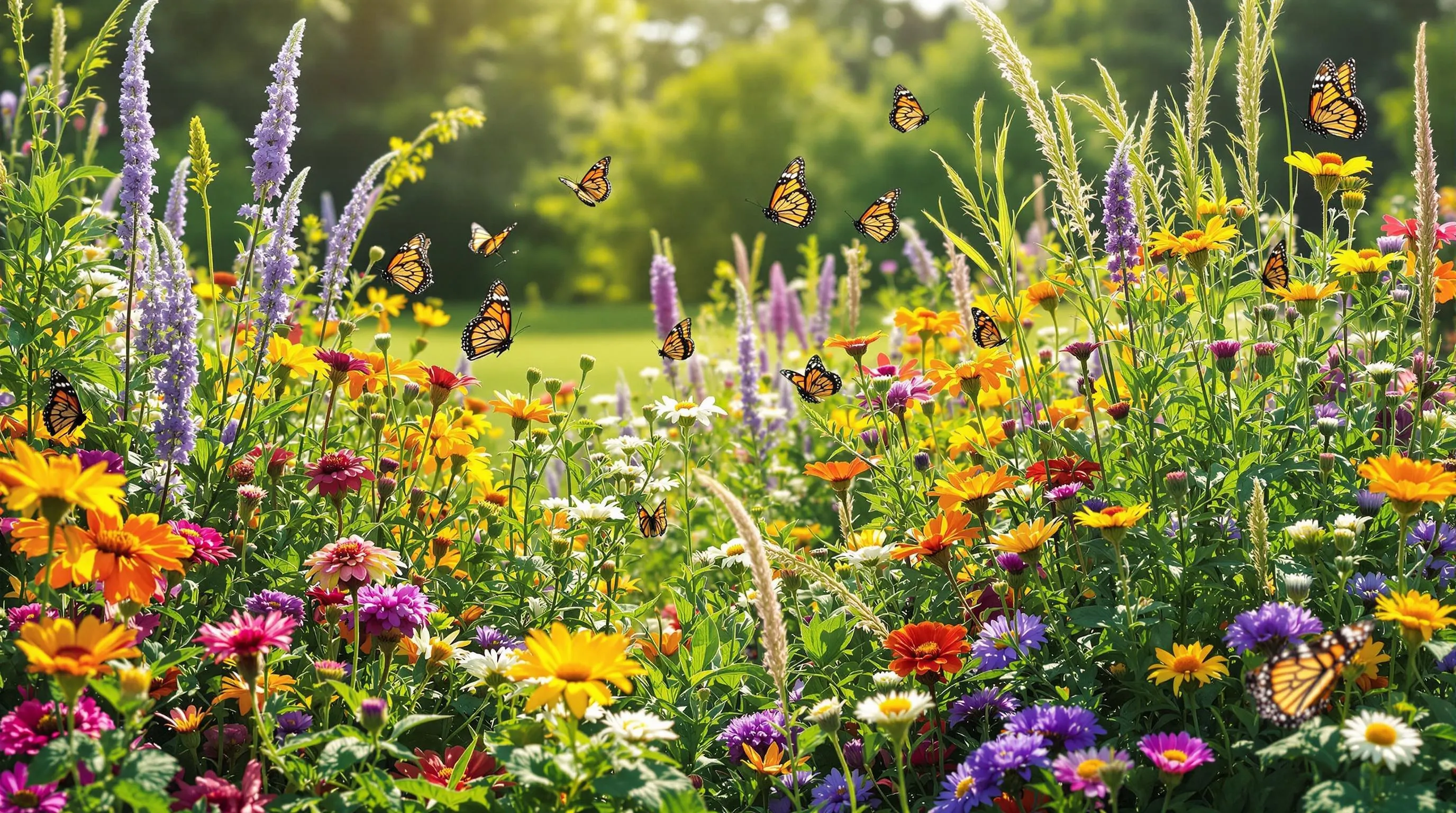
While nectar plants feed adult butterflies, host plants are critical for the butterfly life cycle as they provide food for caterpillars. Different butterfly species require exact host plants to lay their eggs on, ensuring their larvae have proper nutrition when they hatch.
Milkweed: The Monarch’s Lifeline
Milkweed (Asclepias) is absolutely essential for Monarch butterflies, serving as the only plant their caterpillars can eat. The toxins in milkweed are absorbed by Monarch caterpillars, making both the larvae and adult butterflies unpalatable to predators. Plant native milkweed varieties like Asclepias tuberosa (Butterfly Weed) or Asclepias incarnata (Swamp Milkweed) in sunny locations. A cluster of 3-5 plants will create an inviting nursery for Monarch butterflies to lay their eggs, supporting their declining populations during their remarkable migration.
Parsley and Dill for Swallowtails
Black Swallowtail butterflies rely on members of the carrot family (Apiaceae) as host plants. Parsley, dill, fennel, and Queen Anne’s lace are perfect choices that serve double duty in your garden. You’ll enjoy these herbs in your kitchen while providing essential habitat for swallowtail caterpillars. Plant these herbs in sunny locations with well-draining soil and resist the urge to harvest all the foliage when you spot the distinctive black, green, and yellow striped caterpillars feeding on them. Consider dedicating a separate herb patch specifically for butterfly larvae to avoid conflicts between your culinary needs and the butterflies’ lifecycle.
Native Grasses for Skippers
Skipper butterflies, those small, quick-moving butterflies with distinctive hooked antennae, depend on various native grasses as host plants. Little Bluestem (Schizachyrium scoparium), Switch Grass (Panicum virgatum), and Purple Love Grass (Eragrostis spectabilis) serve as excellent host plants for these butterflies. Incorporate these ornamental grasses into sunny borders or meadow gardens to support skipper populations. These grasses also provide winter interest and habitat for other beneficial insects. Leave grass stems standing through winter to protect overwintering eggs or pupae, then cut back in early spring before new growth emerges.
Low-Maintenance Perennials That Butterflies Love
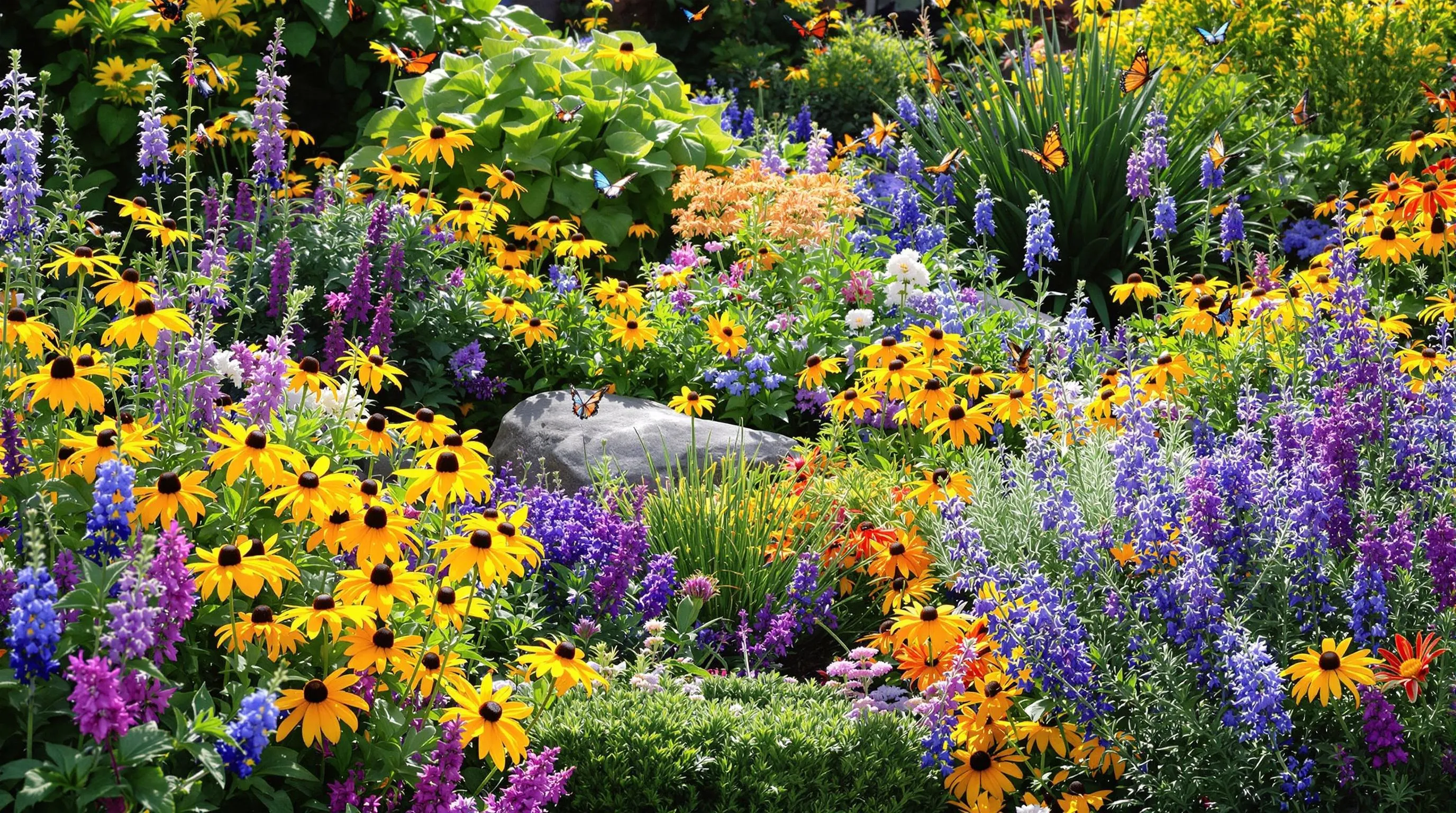
Perfect for busy gardeners, these easy-care perennials deliver maximum butterfly appeal with minimal effort. They return year after year, establishing stronger roots and producing more flowers over time.
Drought-Resistant Sedum
Sedum (stonecrop) thrives in hot, dry conditions and attracts countless butterflies with its flat flower clusters. These succulent perennials need almost no maintenance, surviving harsh summers without supplemental watering once established. Plant ‘Autumn Joy’ or ‘Brilliant’ varieties for late-season nectar that keeps Painted Ladies, Skippers, and Monarchs visiting your garden through fall. Their thick, fleshy leaves store water efficiently, making them perfect for rock gardens or sunny borders where other plants struggle.
Hardy Black-Eyed Susan
Black-Eyed Susans (Rudbeckia) deliver bright golden blooms that serve as butterfly magnets from midsummer through fall. These resilient native perennials withstand poor soil, drought, and neglect while reliably producing nectar-rich flowers year after year. American Lady and Fritillary butterflies particularly favor these daisy-like blooms. Plant in masses for dramatic impact and continuous butterfly activity. Their self-seeding nature means they’ll naturally spread to fill garden spaces, requiring absolutely no deadheading or special care to perform beautifully.
Long-Blooming Salvia
Salvias offer extended blooming periods that provide consistent nectar sources for butterflies throughout the growing season. These aromatic perennials thrive in full sun and well-drained soil, requiring minimal watering once established. Varieties like ‘May Night’ and ‘East Friesland’ produce vibrant purple-blue spikes that attract Swallowtails, Sulphurs, and many other butterfly species. Their natural resistance to deer and rabbits means you’ll never need protective measures, while their drought tolerance eliminates constant watering chores. Simply cut back spent flower stalks to encourage repeat blooming that keeps butterflies returning all season.
Creating a Complete Butterfly Habitat in Your Landscape
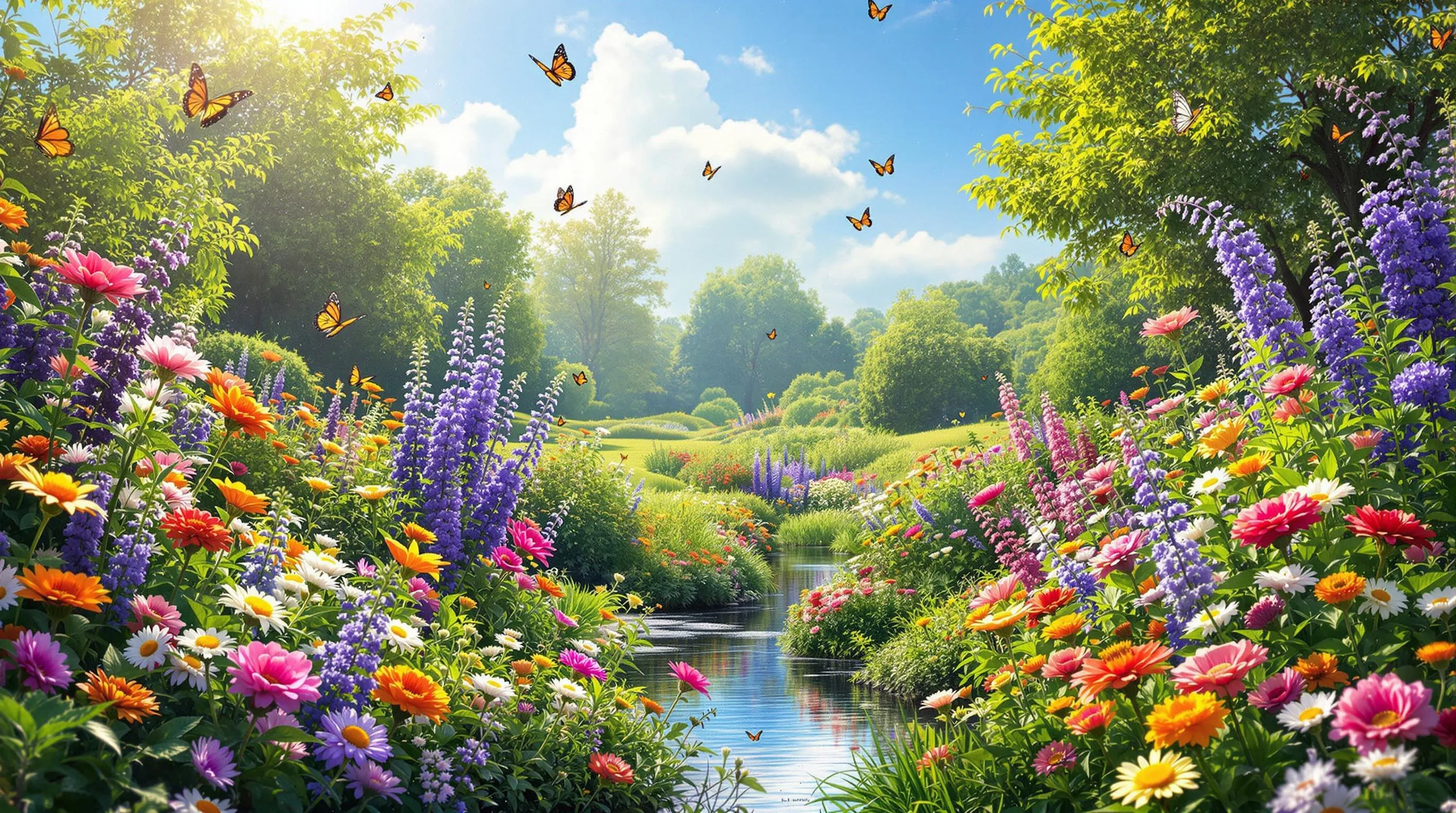
Building on your foundation of nectar and host plants, a truly successful butterfly garden requires a holistic approach to habitat creation. Butterflies need more than just flowers to thrive—they require a complete network that supports every stage of their life cycle.
Providing Water Sources and Shelter
Butterflies need shallow water sources to stay hydrated and obtain essential minerals. Create butterfly puddling spots by filling shallow dishes with sand and water or by placing flat rocks in birdbaths. Keep these areas consistently moist but not flooded. For shelter, incorporate various industry elements like rock piles, log stacks, and dense shrubs where butterflies can hide during poor weather conditions. Include taller plants or small trees as windbreaks to protect delicate wings from strong gusts. These sheltered spaces also provide safe resting spots during nighttime and essential protection during winter months for overwintering species.
Arranging Plants for Maximum Butterfly Attraction
Strategic plant arrangement dramatically increases your garden’s butterfly appeal. Group similar plants in clusters of at least three to create visible “landing pads” that butterflies can easily spot from above. Layer your garden with varying heights—tall plants at the back, medium-height plants in the middle, and shorter varieties in front—to create multiple feeding zones. Position nectar plants in sunny locations where butterflies are most active, typically areas receiving at least 6 hours of direct sunlight daily. Place host plants near nectar sources to create a complete habitat where butterflies can feed and lay eggs within the same area. This thoughtful arrangement minimizes energy expenditure for butterflies and increases their likelihood of establishing populations in your garden.
Avoiding Harmful Pesticides
Pesticides pose a serious threat to butterflies at all life stages. Even products labeled “natural” can harm these delicate creatures. Switch to organic gardening methods that work with nature rather than against it. Introduce beneficial insects like ladybugs and lacewings that naturally control pest populations. Use physical barriers such as row covers to protect vulnerable plants without chemicals. If pest problems persist, opt for targeted answers like insecticidal soaps applied only to affected plants during times when butterflies are less active. Remember that a truly butterfly-friendly garden accepts some level of plant damage as part of supporting the complete life cycle. Caterpillars need to eat leaves to develop—those nibbled edges are signs of a successful butterfly habitat, not garden failure.
Seasonal Planting Guide for Year-Round Butterfly Visitors

Creating a year-round butterfly haven requires strategic planting across seasons. By selecting plants that bloom at different times, you’ll ensure a continuous food source for butterflies throughout their active periods.
Spring Butterfly Magnets
Spring marks the return of butterflies from hibernation or migration, making early-blooming plants crucial for their survival. Plant Virginia bluebells, lilac, and phlox to welcome early butterfly species like Spring Azures and Mourning Cloaks. Bloodroot and violets emerge early, providing essential nectar when few other sources exist. Don’t forget to include flowering trees like redbud and crabapple, which serve as important early-season nectar stations. Plant these spring favorites in spots that receive morning sun to give butterflies a warm place to start their day as they emerge from cool nights.
Summer Blooms for Peak Butterfly Season
Summer represents the height of butterfly activity, requiring abundant nectar sources to support diverse species. Focus on planting zinnias, bee balm, and purple coneflowers that thrive in full sun and provide landing platforms for butterflies like Monarchs, Swallowtails, and Painted Ladies. Incorporate tall verbena and Joe-Pye weed for vertical interest that attracts Tiger Swallowtails and Fritillaries. Maintain continuous blooms by deadheading spent flowers regularly and staggering plantings of annuals like cosmos and sunflowers. Water deeply during dry periods to ensure plants produce ample nectar, as stressed plants reduce nectar production that butterflies depend on during this critical season.
Fall Plants for Migrating Species
Fall gardens become crucial refueling stations for migrating butterflies preparing for long journeys. Plant late-blooming asters, goldenrod, and sedum to provide energy-rich nectar for Monarchs and Painted Ladies during their migration. New England aster and Mexican sunflower offer particularly high-quality nectar that helps butterflies build fat reserves for winter or long flights. Include fall-blooming herbs like mint and oregano that provide accessible nectar in small flowers. Position these autumn bloomers in sheltered locations protected from early frosts to extend their flowering period. These late-season nectar sources can mean the difference between survival and starvation for butterflies making challenging migratory journeys southward.
Container Gardening Options for Butterfly Enthusiasts
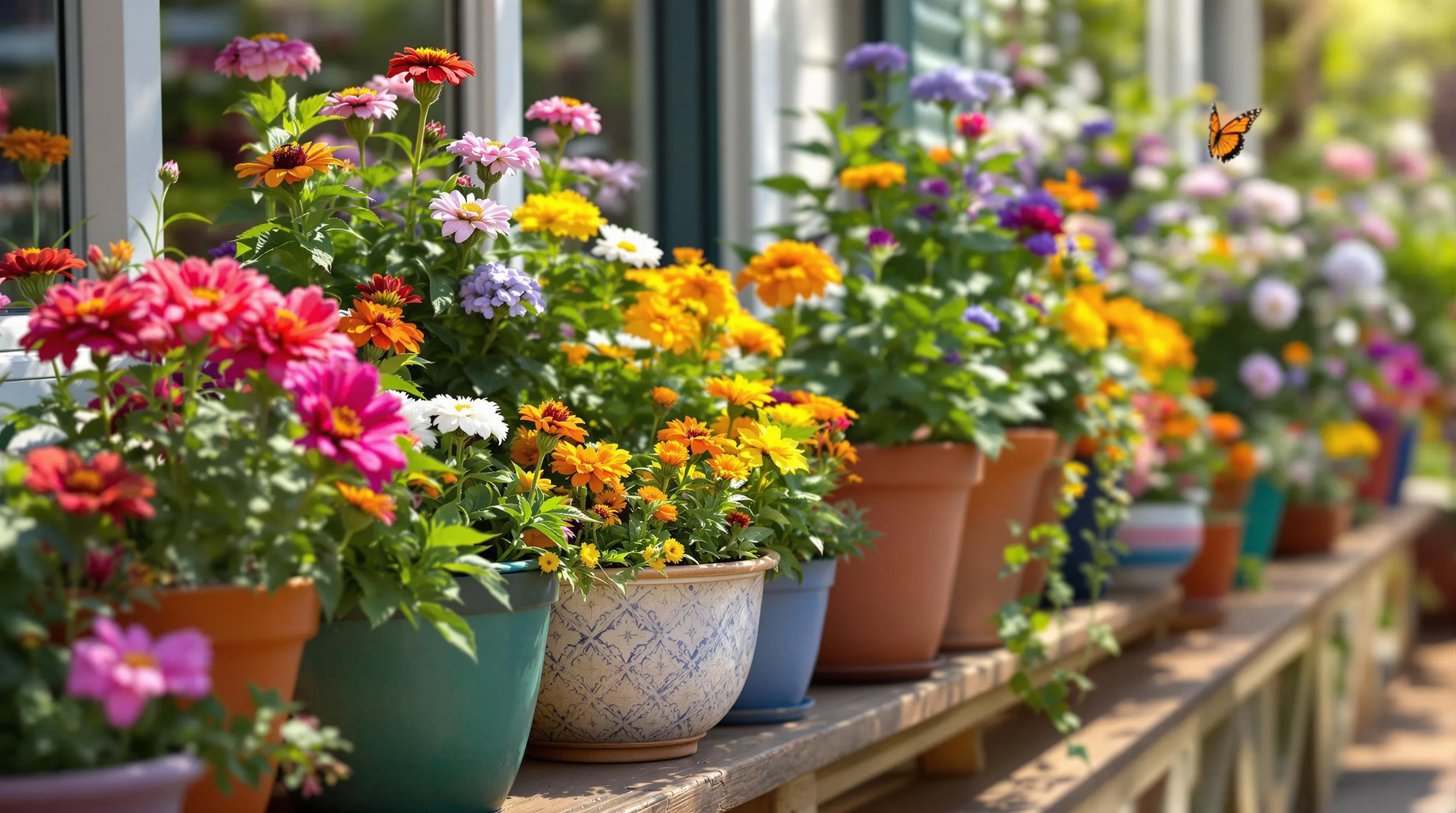
Don’t let limited space prevent you from creating a butterfly haven. Container gardening offers the perfect solution for butterfly enthusiasts with small yards, balconies, or patios. Choose large containers (at least 12 inches deep) with proper drainage holes and fill them with lightweight potting mix. Bright-colored plastic or ceramic pots work best as they retain moisture longer than terracotta. Arrange your containers in sunny locations that receive at least 6 hours of direct sunlight daily for optimal nectar production. Perfect container-friendly butterfly plants include compact varieties of butterfly bush, lantana, zinnias, and marigolds for nectar, while dwarf milkweed varieties support monarch caterpillars. Group containers together to create a concentrated “butterfly station” that’s more visible to passing pollinators. Remember to water more frequently than in-ground gardens, as containers dry out faster, especially during hot summer months.
Regional Plant Recommendations for Butterfly Gardens
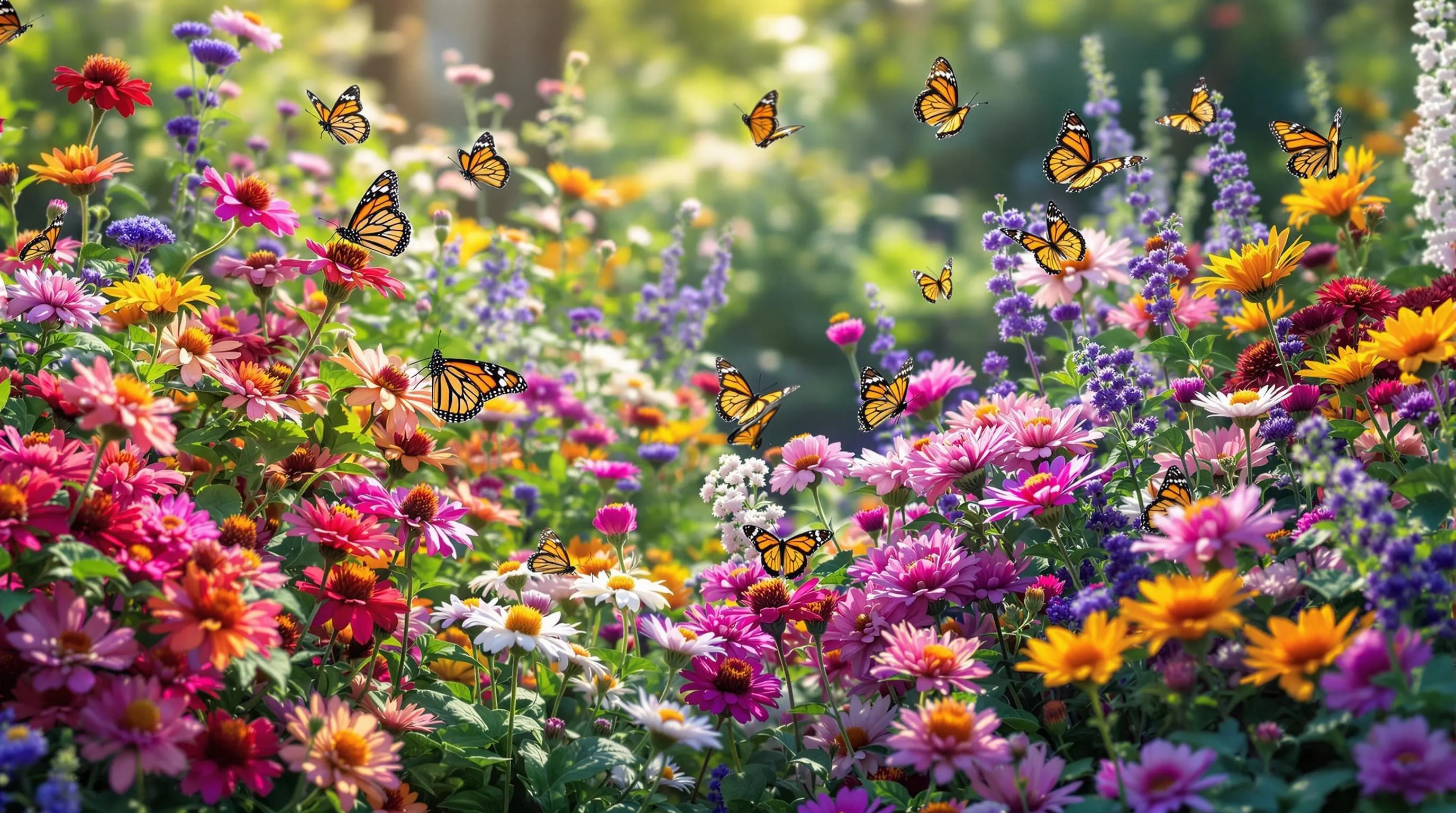
Creating a successful butterfly garden requires selecting plants that thrive in your exact climate and support local butterfly species. Different regions across the United States host unique butterfly populations that have evolved alongside native plants.
Northeast Butterfly Garden Stars
In the Northeast, New England aster (Symphyotrichum novae-angliae) draws in Painted Ladies and Monarchs with its vibrant purple blooms from August through October. Joe-Pye weed (Eutrochium purpureum) reaches impressive heights of 5-7 feet and attracts Tiger Swallowtails with its mauve flower clusters. For spring visitors, plant Eastern redbud (Cercis canadensis) which supports early-season butterflies with its pink blossoms. Northern spicebush (Lindera benzoin) serves as the essential host plant for Spicebush Swallowtails, while tolerating the region’s cold winters and partial shade conditions. These hardy Northeastern natives withstand the region’s variable climate while providing continuous butterfly support throughout the growing season.
Southern Butterfly Favorites
Southern gardens benefit from a longer growing season, allowing for a diverse butterfly plant palette. Gulf fritillary butterflies flock to passion vine (Passiflora incarnata), which serves as both nectar source and host plant. Firebush (Hamelia patens) thrives in hot, humid conditions while attracting many butterfly species with its tubular orange-red flowers. For reliable summer blooms, plant Turk’s cap (Malvaviscus arboreus) which provides nectar for both butterflies and hummingbirds in partly shaded areas. Tropical milkweed (Asclepias curassavica) grows quickly in southern climates, though native milkweed species like butterflyweed (Asclepias tuberosa) better support monarch populations long-term. Gulf Coast gardeners should include salt-tolerant plants like blanketflower (Gaillardia pulchella) which withstands coastal conditions while attracting a variety of butterflies.
Western Native Plants for Butterflies
Western butterfly gardens require drought-tolerant species adapted to the region’s diverse microclimates. California lilac (Ceanothus spp.) attracts many butterfly species with its blue flowers while requiring minimal water once established. Desert marigold (Baileya multiradiata) thrives in poor soil and full sun, making it perfect for southwestern butterfly gardens. Showy milkweed (Asclepias speciosa) provides essential habitat for monarchs throughout the West’s arid regions. For Pacific Northwest gardens, include oceanspray (Holodiscus discolor), which supports various butterfly species and tolerates the region’s wet winters and dry summers. Rocky Mountain gardens benefit from sulfur buckwheat (Eriogonum umbellatum), whose yellow blooms attract hairstreak butterflies while withstanding high altitudes and temperature fluctuations.
How to Design a Butterfly Garden That Works in Any Space
By planting the right butterfly-attracting flowers and providing essential habitat elements you’re doing more than beautifying your space—you’re supporting crucial pollinators and local ecosystems. Your butterfly garden can thrive whether you have acres of land or just a few containers on a balcony.
Start with a mix of nectar plants for adults and host plants for caterpillars then add water sources and shelter. Group similar plants together and avoid pesticides to create a truly butterfly-friendly environment.
Remember that successful butterfly gardening changes with the seasons. With thoughtful plant selection and proper care you’ll enjoy the magical sight of butterflies dancing through your garden from spring through fall while playing a vital role in supporting biodiversity right at home.





